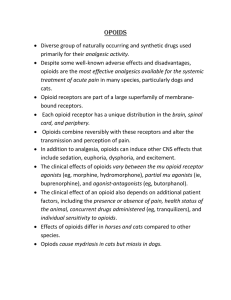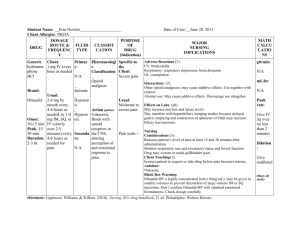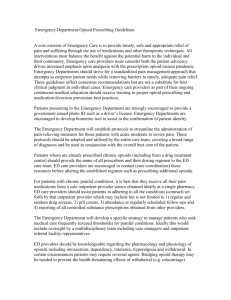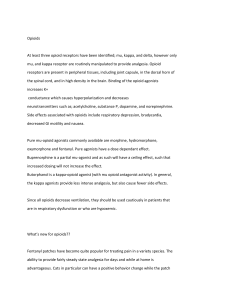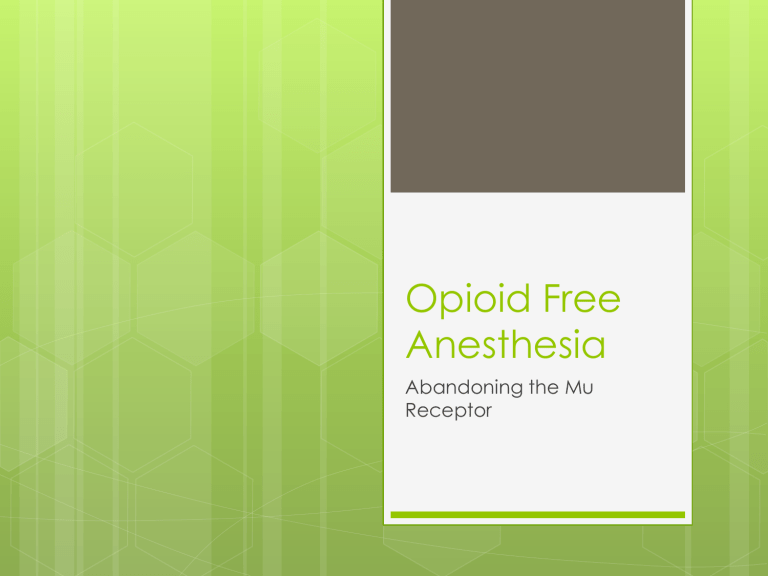
Opioid Free Anesthesia Abandoning the Mu Receptor Objectives Review the current opioid use in the US Review of pain physiology Understand concept of opioid induced hyperalgesia Learn ways to decrease or abstain from the use of opioids in the perioperative arena Opioid Use in the United States US consumes 80% of all opioids while only having 5% of the world’s population Highest-risk group is between ages 35-54 years old Opioid related deaths exceed mortality from firearms and motor vehicles Approximately 4% of prescription opioid users start using heroin 80% of heroin users started using prescription opioids initially US Opioid Deaths Post-op Opioid Use Study of 39,140 opioid-naïve patients having major surgery 49.2% D/C with opioid prescription 3.1% on opioids 90 days after surgery Study of 391,139 opioid-naïve patients having short-stay surgery 7.7% were prescribed opioids 1 year after surgery 44% more likely to be on opioids at 1 year if prescribed within 7 days of surgery Post-op Opioid Use CDC study of 1.3 million patients demonstrated probability of long term opioid use increased after 5 days of opioid use 6% on opioids at 1 year with 5 days use 13.5% on opioids at 1 year with ≥ 8 days use 29.9% on opioids at 1 year with ≥ 31 days use Post-op Opioid use Is opioid addiction a surgical complication? Study of 36,177 patients 80.3% had minor surgical procedure 19.7% had major surgical procedure Minor surgical procedure had 5.9% persistent opioid use Major surgical procedure had 6.5% persistent opioid use Anatomy of Pain Anatomy of Pain 3 types of afferent fibers Aβ fibers Aδ fibers C fibers Aδ fibers Lightly myelinated and small diameter (2-5 μm) Respond to mechanical and thermal stimuli Transmit rapid, sharp pain Allow localization of pain Responsible for initial response to acute pain C fibers Unmyelinated and smallest fiber (<2μm) Respond to chemical, mechanical, and thermal stimuli Transmit slow, diffuse, dull pain Aβ fibers Highly myelinated and large diameter (8-13 μm) Respond to light touch and non-noxious stimuli Responsible for activation of descending pathway Substances released by Nociceptive fibers Aδ fibers release glutamate into the synaptic cleft with 2nd order neurons in the dorsal horn C fibers release both Substance P and glutamate into the synaptic cleft with 2nd order neurons in the dorsal horn Glutamate Key excitatory neurotransmitter the somatosensory system Released from presynaptic Aδ and C fibers Activates postsynaptic AMPA and NMDA receptors NMDA receptors are inactive due to Mg ion Constant depolarization causes Mg ion to release Release of Mg ion causes influx of Ca ions and intracellular changes Ca ions cause increased NO production which increases glutamate release from presynaptic nociception fibers. NMDA Receptor Substance P Key excitatory neuropeptide in the somatosensory system Released by C fibers primarily Activate NK1 receptors in Lamina I and II Anatomy of the Dorsal Spinal Cord Dorsal spinal cord divided into distinct gray matter lamina. Aδ fibers terminate in Rexed lamina I, III to V C fibers terminate in Rexed lamina I and II Aβ fibers terminate in Rexed lamina III to V Laminae I and II are nociceptive specific cells Laminae III to V are wide dynamic range cells Anatomy of the Dorsal Spinal Cord What is Pain? A stimulus that causes protective behaviors that promote healing An alarm to signal the body of actual or potential tissue damage Well defined onset associated with tissue injury from surgery, trauma, or disease related injury from inflammation Types of Pain Somatic Well-localized pain Described as sharp, crushing, tearing pain Follows a dermatomal pattern Visceral pain pain Poorly localized Described as dull, cramping, or colicky pain Associated with peritoneal irritation, dilation of smooth muscle or a tubular passage Stages of Pain Transduction- stimulus converted to electrical signal Transmission- converted electrical activity conducted through the nervous system Modulation- Alteration of signal along the pain transmission pathway Perception- final stage of where there is a subjective sensation of pain Transduction of Pain Stimuli Nociceptors Free nerve endings of Aδ and C fibers Located in the skin, viscera, muscles, joints, and meninges. Stimulated by mechanical, thermal, or chemical stimuli. Transform stimuli to electrical signals that are sent to the central nervous system (CNS). Transduction Peripheral sensitization Tissue injury causes release of numerous chemicals (i.e. bradykinin, prostaglandins, serotonin, cytokines, and hydrogen ions) These chemicals may: Directly induce pain transmission Increase excitability of nociceptors and decrease pain threshold Transmission of pain Impulse previously translated into electrical signal is sent through afferent nerve fibers to the dorsal horn of the spinal cord, and then along the sensory tracts to the brain through 2nd and 3rd order neurons Modulation Dampening or amplifying of pain signal Dampening of pain signal by descending inhibitory pathway PAG Rostral Ventromedial Medulla Opioid receptors on presynaptic afferent neuron are responsible for dampening effect Descending Inhibitory Pathway Midbrain periaqueductal gray (PAG) primary control center for descending pathway Stimulated by ascending pathway or endorphins (endogenous and exogenous) PAG stimulation activates neurons in the rostral ventromedial medulla, causing release of serotonin in dorsal horn Serotonin released in dorsal horn activates interneurons in Laminae II (aka substantia gelatinosa) These interneurons release endogenous opioid neurotransmitters Endogenous Opioid Neurotransmitters Endorphin or Dynorphin activate mu and kappa opioid receptors on the afferent C and A-delta fibers in substantia gelatinosa Activation of the mu/kappa receptor inhibits the release of substance P from afferent fibers, decreasing transmission of pain to brain for perception Perception Conscious awareness of pain End result of transduction, transmission, modulation, and psychological aspects Opioid Induced Hyperalgesia MOA of Opioids Activate intracellular G-proteins Hyperpolarization of afferent neuron Inhibit Ca2+ channels from opening, preventing influx of calcium ions Opening of K+ channels, increases efflux of potassium ions Inhibition of excitatory neurotransmitter release (Glutamate and Substance P) Opioid Induced Hyperalgesia (OIH) State of nociceptive sensitization caused by exposure to opioids Patient becomes more sensitive to certain painful stimuli May occur after single dose of an opioid Remifentanil>Fentanyl>Morphine Causes of OIH Central glutaminergic system Spinal dynorphins Descending inhibitory pathways Genetic influences Decreased reuptake and enhanced nociceptive response NMDA role in OIH Glutamate plays a central role in development of OIH Increased glutamate available to activate NMDA receptors Overproduction of cAMP due to Gs protein activation by opioids Inhibition and OIH of NMDA prevents tolerance Spinal dynorphins Dynorphin levels increase with prolonged mu-receptor agonist administration Increased dynorphin levels cause release of excitatory neuropeptides such as calcitonin gene related peptide, which increases pain transmission Studies show that reversal of dynorphin can restore analgesic effects of morphine Descending Inhibitory Pathway OIH Opioid modulation of pain at the supraspinal level has a unique action on a subset of neurons in the RVM There is an actual increase in spinal nociceptive processing when they are activated by opioids Lesioning of the descending pathway to the dorsolateral funiculus prevented the release of these excitatory neuropeptides Injection of local anesthetics into the RVM prevented or reversed OIH and tolerance to opioids Genetic Influences on OIH The primary genetic influence is the activity of Catechol-O-methyltransferase (COMT) The substitution of the amino acid valine for methionine decreases the breakdown of dopamine and noradrenaline by up to 400% Increased dopamine/noradrenaline levels increase pain sensitivity Opioid Free Anesthesia What is Opioid Free Anesthesia (OFA) The absence of using mu-receptor agonist opioids intraoperatively It is not the total absence of opioids in the entire perioperative period, but use of opioids as the last line of treatment instead of the first in the postoperative period It is a scientifically-based, systematic treatment of the surgical patient Why use opioids? Opioids were primarily used initially because their safe intraoperative profile minimal cardiac depression Blunting of pain transmission Provide the basis of postoperative pain control Why not use opioids Negative side effect profile Opioids suppress the immune response Respiratory depression, N/V, pruritus, urinary retention Suppression of Natural Killer cells Cause cognitive/sleep dysfunction Increased risk for addiction postoperatively Increased risk of chronic pain with opioid administration Benefits of OFA Stable hemodynamics intraoperatively Decreased risk of respiratory depression Prevention of chronic pain Increased effectiveness of opioids administered postoperatively Decreased incidence of N/V, pruritus, constipation, urinary retention, immune suppression, and cognitive/sleep dysfunction Methods of OFA Management of peripheral sensitization Management of central sensitization Prevention of OIH Weight based dosing on drugs IBW Adjusted body weight for patients whose actual body weight is 30% greater than IBW Peripheral Senstization Inflammatory process caused by tissue injury Release of inflammatory mediators i.e. bradykinin, prostaglandins, interleukins, and substance P Decreased pain threshold of C and Aδ fibers Increased frequency and amplitude of pain signal to spinal cord Management of Peripheral Sensitization Local Anesthetics Peripheral nerve blocks Lidocaine infusion Steroids Decadron NSAIDS Toradol Celebrex Cannaboids Regional Anesthesia If it can be blocked, block it! Upper extremity surgeries Lower extremity surgeries Brachial plexus blocks Axillary block Terminal nerve blocks Fascia iliaca block FNB or ACB Popliteal Sciatic Block IPACK block Lateral genicular nerve block Truncal blocks TAP block Midaxillary vs Subcostal IL/IH block Rectus sheath blocks Quadratus Lumborum block PECS Block Truncal Blocks Midaxillary TAP Blocks Somatic pain coverage of T10 to L1 dermatomes Adequate postop analgesia for various laparoscopic and open procedures with incision at or below umbilicus Appendectomy Umbilical hernia repair Inguinal hernia repair Colectomy C-section Subcostal TAP blcok Somatic pain coverage of T7 to T10 dermatomes Adequate post op analgesia for surgeries with incision above the umbilicus Cholecystectomy Colectomy Upper ventral hernia repair Subcostal TAP block Rectus Sheath Blocks Somatic pain coverage of T7 to L1 Length of analgesia is inferior to TAP block Adequate coverage for midline incisions Rectus Sheath Block Quadratus Lumborum Block Provides somatic and visceral coverage of T7 to L1 dermatomes depending on location of block Most efficacious QL block is the QL3 Deposit of local anesthetic between quadratus lumborum and psoas muscle Most ideal for large abdominal surgeries Quadratus Lumborum Block PECS Blocks PECS 1 block Injection of local anesthetic between pectoralis major and pectoralis minor at level of 3rd rib Blocks the lateral and medial pectoral nerves Adequate analgesia for portacaths, cardiac implants, anterior throacotomies PECS 2 block Injection of local anesthetic between pectoralis minor and serratus anterior muscles at level of 4th rib Adequate for tumor resections, mastectomies, sentinel node biopsies PECS Blocks Lidocaine Infusion Anti-inflammatory effect by prostaglandin inhibition Useful in abdominal and urological procedures Avoid use concomitanly with PNB Dosage Initial bolus: 1.5mg/kg Maintenance: 2mg/kg/hr Postoperative: 1.33mg/kg/hr Decadron Glucocorticoid steroid Inhibits the production of prostaglandins, bradykinin, histamine and leukotrienes Caution in diabetic patients Advise that insulin requirement may be increased for next 24 hours Literature disputes any wound healing effects Dosage 0.2mg/kg (10-20mg on average) Toradol Inhibits production of prostaglandins, bradykinin, and histamine Strong analgesic effect Equipotent to morpine 10mg Caution in elderly, renal failure, or platelet dysfunction Dosage 15mg at induction, 15mg at end Half dosages for elderly Some studies say 15mg is as effective as 30mg dose Celebrex COX-2 inhibitor Inhibits prostaglandin synthesis Decreased risk of bleeding, GI side effects, and AKI Usage postoperatively decreases narcotic use and duration Dosage: Preoperatively 400mg PO Postoperativeley 200mg PO BID for 7 days Cannabinoids Endocannabinoid system is a major endogenous pain control system Anti-inflammatory and analgesic properites Promising studies involve inhibiting the enzymes that are released during stress that inhibit the endocannabinoid system from functioning Ligands that activate CB1 receptors are promising for nociceptive alteration Ligands that activate CB2 receptors are promising for anti-inflammatory properties CR845 Peripherally acting Kappa Opioid Receptor Agonist Analgesic, anti-inflammatory, and antipruritic Poor blood-brain barrier penetrating capability Management of Central Sensitization Substance Clonidine Dexmedetomidine Glutamate P inhibition antagonist Ketamine N2O Magnesium Gabapentinoids Substance P Inhibitors Clonidine a2-adrenoreceptor agonist Decreases sympathetic outflow from lower brainstem region Decreases release of NE at both peripheral and central terminals Analgesic properties are due to both peripheral and central a2adrenoreceptor agonism Clonidine Peripheral analgesia CNS analgesia Blocking of pain transmission conducted through C fibers Result of interaction with inhibitory G coupled proteins Activation of a2-adrenoreceptors in the dorsal horn Decreased release of Substance P and NE Activation of a2-adrenoreceptors in locus coeruleus responsible for supraspinal analgesia and sedation Clonidine Avoid Bradyarrthymias Patients who are afterload dependent Ie severe AS Coronary artery disease due to possible HOTN Strong in patients with: considerations Renal patients require less dose Low starting BP Clonidine PO dose: 3-5mcg/kg (IBW) given 1-2 hours preop Bioavailbility is 75-95% IV dose: Give 1.5mcg/kg (IBW) on induction, following incision if a sympathetic response is detected give additional 1.5mcg/kg Total dose 3mcg/kg, may give up to 5mcg/kg (increased SE and sedation) Dose may be given over 30 minutes in preop Long half life up to 18 hours with both PO and IV dose Dexmedetomidine Strong a2-adrenoreceptor agonist (1600:1) Same MOA as clonidine Less SE profile than clonidine Stronger analgesic effect than clonidine Dexmedetomidine Use with caution in patients with: Heart block Severe ventricular dysfunction Hypovolemic patients Diabetes Uncontrolled hypertension Elderly Dexmedetomidine Dosage: Initial bolus: 0.5-1mcg/kg over 10 minutes in preop Maintenance: 0.3-0.5mcg/kg/hr Postoperative infusion: 0.2-0.5mcg/kg/hr Short half-life of 2-2.6 hrs Glutamate Antagonists Ketamine NMDA antagonist Prevents glutamate from depolarizing neuron Reverse opioid tolerance and opioid induced hyperalgesia Recent research shows efficacy in treating CPRS, PTSD, anxiety, and depression Low dose over long infusion times for repeated exposures Ketamine Dosage: Initial bolus: 0.5mg/kg Maintenance: 5-10mcg/kg/min Alternative use is to administer 10-20mg prior to administration of opioid Subanesthetic dose decreases risks of postoperative hallucinations N2O NMDA antagonist Minimal acute pain analgesia Short duration of action may be reason why Strong evidence may prevent development of chronic pain in at risk patients Magnesium Supplementation with exogenous magnesium changes concentration gradient and prevents disassociation of Mg ion from NMDA receptor channel, preventing depolarization of postsynaptic neuron Dosage Initial bolus 20-50mg/kg over 10-15 minutes Maintenance 10-25 mg/kg/hr Gabapentinoids Presynaptic binding to the α-2-δ subunit of voltage-gated Ca+2 channels inhibiting Ca+2 influx Prevents release of glutamate, norepinephrine, substance P, and calcitonin gene-related peptid Gabapentin and Pregabalin Gabapentin Originally used as an anticonvulsant medication to treat epilepsy Decreases opioid use and decreases PONV Dosage Initial: 600mg-1200mg PO At least 1 hour prior to surgery Maintenance: 300mg-600mg PO BID Pregabalin Faster absorption and onset than gabapentin Analgesia effects similar to gabapentin Dosage Initial: 150-300mg PO At least 1 hour prior to surgery Maintenance: 75-150mg PO BID Analgesics Analgesics Acetaminophen Esmolol Nubain Acetaminophen MOA is not clearly understood PO vs IV Best to give either prior to incision Dosage Initial: 1gm PO or IV Maintenance 1gm PO or IV q 6-8 hours Esmolol Selective β1-adrenoreceptor antagonist Metabolized by RBC esterase Analgesic MOA theories Central analgesia by inhibition of βadrenoreceptors altering G protein activation Inhibition of neurotransmitter release in substantia gelatinosa neurons Esmolol Dosage Initial: 0.5-1mg/kg bolus Maintenance: 5-15 mcg/kg/min Nubain Mechanism of action Potency Equipotent to morphine ¼ potency of Narcan Dosage Full kappa agonist and partial mu antagonist Induction: 0.2mg/kg PACU: 5-10mg up to total dose of 20mg Side effects Sedation, HOTN, bradycardia Cocktail Maintenance Infusion Lidocaine 2mg/kg/hr, Ketamine 5mcg/kg/min, Magnesium 10mg/kg/hr, Precedex 0.4mcg/kg/min 100mL bag remove 20mL Inject Lido 2% 20mL, Ketamine 60mg, Magnesium 2gm, and Precedex 80mcg into bag Infuse at 0.5mL/kg/hr Run infusion up until starting incision closure Emergent Ectopic Rupture 36 yo Female Ectopic pregnancy rupture Hgb 7, tranfused 2 units of PRBC OFA technique Transverse Colectomy Pre 32 yo Female Bilateral QL3 block OFA technique Required Morphine 4mg night of surgery Bowel function returned next morning Discharged POD2 The Society for Opioid Free Anesthesia goopioidfree.com
